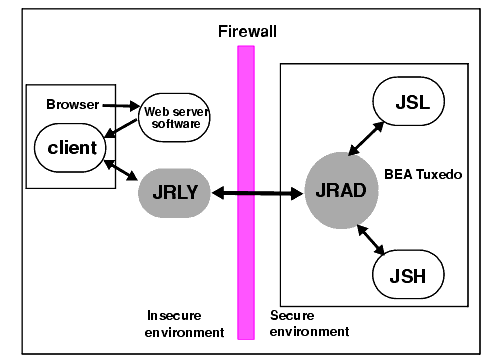


|

|
|
|
|
Jolt Relay
The combination of the Jolt Relay (JRLY) and its associated Jolt Relay Adapter (JRAD) is typically referred to as the Internet Relay. Jolt Relay routes messages from a Jolt client to a JSL or JSH. This eliminates the need for the JSH and BEA Tuxedo to run on the same machine as the Web server (which is generally considered insecure). The Jolt Relay consists of the two components illustrated in the figure Jolt Internet Relay Path.
The JRLY is the Jolt Relay front-end. It is not a BEA Tuxedo client or server and is not dependent on the BEA Tuxedo version. It is a stand-alone software component. It requires only minimal configuration to allow it to work with Jolt clients.
The JRAD is the Jolt Relay back-end. It is a BEA Tuxedo system server, but does not include any BEA Tuxedo services. It requires command line arguments to allow it to work with the JSL and the BEA Tuxedo system.
Note: The Jolt Relay is transparent to Jolt clients and Jolt servers. A Jolt server can simultaneously connect to intranet clients directly, or through the Jolt Relay to Internet clients.
Jolt Internet Relay Path

This figure illustrates how a browser connects to the Web server software and downloads the BEA Jolt applets. The Jolt applet or client connects to the JRLY on the Web server machine. The JRLY forwards the Jolt messages across the firewall to the JRAD. The JRAD selectively forwards messages to the JSL or appropriate JSH.
Jolt Relay Failover
There are two points of failovers associated with JRLY:
Jolt Client to JRLY Connection Failover
If one server address does not result in a successful session, the failover function allows the Jolt Client API to connect to the next free (unconnected) JRLY specified in the argument list of the API. To enable this failover in an NT environment, multiple NT JRLY services can be executed. In a non-NT environment, multiple JRLY processes are executed. Each JRLY (service or process) has its own configuration file. This type of failover is handled by Jolt 1.2.1 client API new features that allow you to specify a list of Jolt server addresses (JSL or JRLY).
JRLY to JRAD Adapter Connection Failover
Each JRLY configuration file has a list of JRAD addresses. When a JRAD is unavailable, JRLY tries to connect to the next free (unconnected) JRAD, in a round-robin fashion. Two JRLYs cannot connect to the same JRAD. Given these facts, you can make the connection efficient by giving different JRAD address orders. That is, if you make one extra JRAD available on standby, the first JRLY that loses its JRAD connects to the extra JRAD. This type of failover is handled by JRLY alone.
If any of the listed JRADs are not executing when JRLY is started, the initial connection fails. When a Jolt client tries to connect to JRLY, the JRLY again tries to connect to the JRAD.
To accommodate the failover functionality, you have to boot multiple JRADs by configuring them in the UBBCONFIG file.
Jolt Relay Process
The JRLY (front-end relay) process can be started before or after the JRAD is started. If the JRAD is not available when the JRLY is started, the JRLY attempts to connect to the JRAD when it receives a client request. If JRLY is still unable to connect to the JRAD, the client is denied access and a warning is written to the JRLY error log file.
Starting the JRLY on UNIX
Start the JRLY process by typing the command name at a system prompt.
jrly -f config_file_path
If the configuration file does not exist or cannot be opened, the JRLY prints an error message. Refer to Appendix B, System Messages. for details about the Jolt Relay error messages.
If the JRLY is unable to start, it writes a message to standard error and attempts to log the startup failure in the error log, then exits.
JRLY Command-Line Options for NT
This section describes command-line options that are available from the NT version of JRLY.exe. Note the following:
The JRLY command line options are detailed in the following table JRLY Command-Line Options for NT.
JRLY Command-Line Option for UNIX
There is only one JRLY command-line option for UNIX:
JRLY Configuration File
The format of the configuration file is a TAG=VALUE format. Blank lines or lines starting with a "#" are ignored. The following listing contains an example of the formal specifications of the configuration file.
Specification of Configuration File
LOGDIR=<LOG_DIRECTORY_PATH>
ACCESS_LOG=<ACCESS_FILE_NAME in LOGDIR>
ERROR_LOG=<ERROR_FILE_NAME in LOGDIR>
LISTEN=<IP:Port combination where JRLY will accept connections>
CONNECT=<IP:Port combination associated with JRAD>
SOCKETTIMEOUT=<Seconds for socket accept()function>
Note: SOCKETTIMEOUT is the duration (in seconds) of which the relay NT service blocks the establishment of new socket connections to allow network activity (new connections, data to be read, closed connections). It is valid only on NT machines.
SOCKETTIMEOUT also affects the SCM. When the SCM requests that the service stop, the SCM needs to wait at least SOCKETTIMEOUT seconds before doing so.
The following listing shows an example of the JRLY configuration file. The CONNECT line specifies the IP address and port number of JRAD machine.
Example of JRLY Configuration File
LOGDIR=/usr/log/relay
ACCESS_LOG=access_log
ERROR_LOG=errorlog
# jrly will listen on port 4444
LISTEN=200.100.10.100:4444
CONNECT=200.100.20.200:4444, 200.100.20.200:5555,...
SOCKETTIMEOUT=30 //See text under listing
The format for directory and file names is determined by the operating system. UNIX systems use the forward slash (/). NT systems use the backslash (\). If any file specified in LOGDIR, ACCESS_LOG or ERROR_LOG cannot be opened for writing, the JRLY prints an error message on stderr and exits.
The formats for host names and port numbers are shown in the following table.

|

|

|
|
|
|
Copyright © 2000 BEA Systems, Inc. All rights reserved.
|